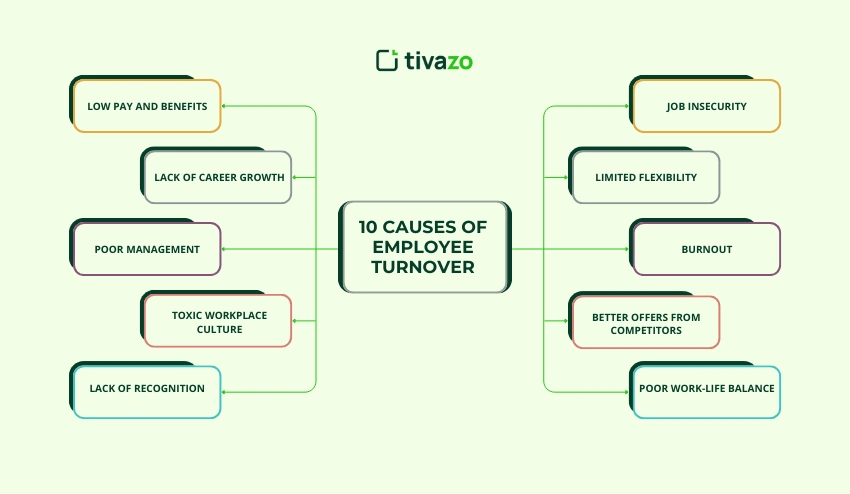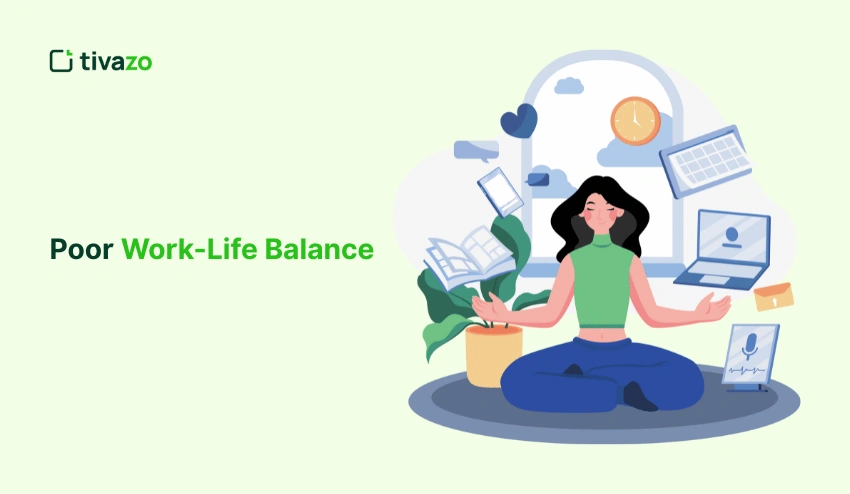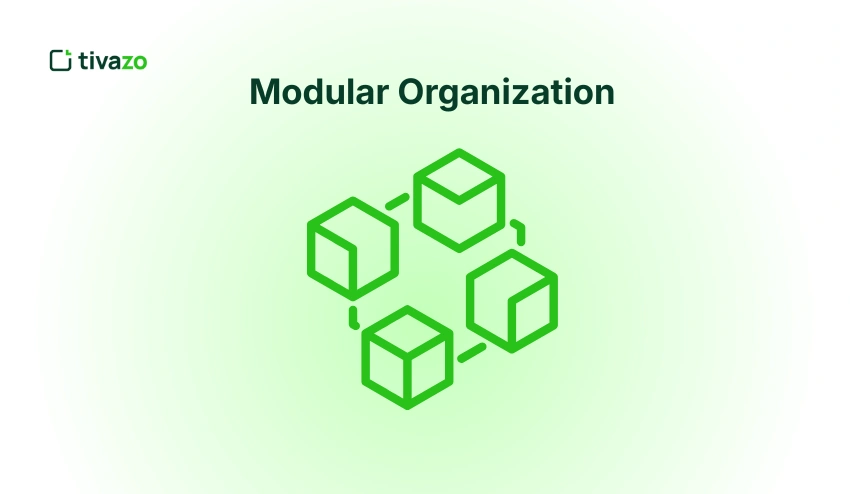Why do many businesses have a high employee turnover even though they are offering more pay and benefits? The reality is that high turnover extends beyond paychecks- it is usually linked to more underlying causes such as workplace culture, job fulfillment, and career development opportunities.
In the current competitive world, organizations cannot afford the ever-increasing cost of employee turnover. Each exit leads to more recruiting, onboarding, and training costs, as well as destabilizing the workforce and depressing employee morale.
In this blog, we will examine the top 10 causes of employee turnover, both voluntary and involuntary, that can drive people to leave. Knowing these reasons, leaders can develop better employee retention plans, enhance employee engagement, and develop an environment in which employees would like to stay and develop.
What is Employee Turnover?
Employee turnover is the rate at which employees leave a company and are replaced within a specific period. It is usually measured monthly or annually and helps businesses understand workforce stability.
Turnover may indicate that there is a bad work culture, poor job satisfaction, or a lack of career development opportunities. On the bright side, a good rate of turnover indicates that an organization is effectively keeping its talent and avoiding the cost of hiring.
In this era, organizations, regardless of their industry, are paying more attention to the rate of employee turnover since not only does it raise the cost of recruitment, but it also affects morale and the overall productivity of employees. Understanding the meaning of employee turnover and its importance enables HR professionals to develop employee retention strategies and enhance business performance in the long term.
Top 10 Reasons For Employee Turnover
Employee turnover may interfere with business operations, raise recruitment expenses, and decrease the productivity of the team. It is important to understand why employees quit in order to develop effective employee retention strategies. With the consideration of these factors, organizations will be able to enhance workforce stability and employee satisfaction.

1. Low Pay and Benefits
One of the most popular causes of employee turnover is low pay. The employees anticipate that their pay will be proportional to their skills, experience, as well as their contribution. When pay and benefits are lower than those in the industry, the staff would be more inclined to look at other opportunities.
Poor pay will not only encourage turnover but also have an impact on morale. When employees feel underpaid, they become disengaged, reduce productivity, and create a risk of resignation. This may affect the overall business performance and cohesion of the team.
To minimize turnover, organizations ought to conduct a periodic review of the salary scales and an attractive benefits package. Employees can be offered bonuses, health plans, and retirement contributions to make employees feel appreciated, which will encourage long-term loyalty.
2. Lack of Career Growth
Workers tend to resign because of a lack of promotion opportunities, and this is one of the primary causes of employee turnover. Staff will lack clear promotion or skill development avenues and consequently feel stagnant in their jobs.
Organizations that do not offer any training, mentorship, or career development strategies tend to experience a greater turnover rate. Employees desire to develop professionally, and the inability to do it can drive them to rival companies.
The institution of structured career development programs enables the reduction of employee turnover. Offering workshops, certifications, and internal promotions will demonstrate that the company is interested in the future of its employees.
3. Poor Management
Ineffective leadership is one of the major causes of employee turnover. Employees may be frustrated by managers who micromanage, do not communicate expectations, and/or fail to acknowledge accomplishments.
Employees who have a bad manager can feel undervalued, stressed, or may not feel like they are part of the business. This usually leads to voluntary resignations and high turnover.
Employee turnover can be reduced by training managers in leadership, communication, and conflict resolution. Trust, engagement, and long-term retention are achieved through supportive and transparent management.
4. Toxic Workplace Culture
An unfavorable environment is a major factor that increases employee turnover. Workplaces with favoritism, bullying, or no collaboration repel employees.
Toxic cultures harm the morale of the employees and may lead to high levels of employee absenteeism. Employees can get depressed or feel lonely and unwanted, thereby seeking greener pastures elsewhere.

Promoting inclusivity, collaboration, and free communication lowers workforce turnover. Organisations with a good culture will attract and retain the best talent.
5. Lack of Recognition
When employees feel like they are not valued, they tend to put less effort and quit faster, raising employee turnover. Rewards encourage employees and promote positive work.
In the absence of recognition, employees may not feel that their efforts are rewarded, which will decrease their job satisfaction. This may cause a lack of commitment and eventual resignation.
Awarding employees, recognition-related shout-outs, or performance bonuses can also help minimize employee turnover. Employees who feel valued would have a better chance of remaining loyal and effective.
6. Job Insecurity
The layoff, misunderstanding contracts, or project instability are some of the factors that contribute to employee turnover. Employees who are afraid of losing their jobs tend to seek out more secure alternatives.
Insecurity at the job decreases engagement and productivity. Employees can end up worrying more about their future than doing their job well
The turnover of employees can be reduced by maintaining open communication regarding company performance and by offering stable contracts. Employees feel more loyalty and long-term retention when job security is assured.
7. Limited Flexibility
Stiff work hours or the absence of work-at-home opportunities are becoming more and more associated with turnover. Today, employees place a premium on flexibility as to where, when, and how they work.
Unless there are flexible arrangements, employees will not be able to balance personal and professional obligations, leading to dissatisfaction and eventual resignation.
Remote work, flexible hours, and/or hybrid work are also offered to reduce employee turnover. Flexibility increases employee engagement, employee satisfaction, and overall retention.
8. Burnout
Too much work, unreasonable deadlines, and stress are the biggest causes of employee turnover. Burnout lowers energy, concentration, and job satisfaction.
Employees who undergo burnout can feel undervalued or overworked, which further elevates the chances of quitting. This may increase the costs of recruitment and reduce productivity.
Burnout can be tackled by organizations by ensuring that workloads are balanced, mental health is supported, and wellness programs are in place. Reduced burnout results in a reduction in employee turnover and a healthier workforce.
Read More: Toxic Productivity Signs: 8 Ways to Avoid Burnout & Hustle Culture
9. Better Offers from Competitors
Employee turnover will occur when top performers are lured to other, more attractive opportunities. In competitive markets, retention becomes difficult unless one has proactive strategies
The competitors can attract employees due to higher salaries, better benefits, or more flexible job offers. Inability to meet the market standards raises the rate of turnover.
Employee turnover can be minimized by regular benchmarking of salaries, enhancing benefits, and establishing a good working culture. Rewarding talent keeps employees longer in the company.
10. Poor Work-Life Balance
The lack of work-life balance is an increasing priority for employees, and as such, it is an employee turnover factor. Burned-out employees might not cope with stress and health problems and may be dissatisfied.
The imbalance usually results in disengagement and resignation. Employees who feel that they are overwhelmed at all times will demand jobs that provide them with personal time and flexibility.

Flexible schedules, time-off policies, and a manager who is supportive of work-life balance will promote work-life balance, reduce employee turnover, and increase employee engagement.
What is a good employee turnover rate?
An acceptable employee turnover rate differs depending on the industry, but an average of 10-15% percent per year is healthy. It means that a firm can keep the majority of its talent and still have room to have new views and room to grow.
High turnover is an indicator of possible problems with the workplace culture or employee engagement, or job satisfaction, whereas very low turnover can indicate stagnation. This metric enables organizations to initiate effective employee retention policies, stability of the workforce, and reduce the cost of employee turnover. It is important to understand what a healthy turnover rate is in order to succeed in business in the long run.
How do I Calculate Employee Turnover Rate?
Calculating employee turnover rate helps businesses understand workforce stability and plan effective employee retention strategies. Here’s how to do it step by step:
- Count the number of employees who left your organization during a specific period (voluntary or involuntary).
- Determine the average number of employees during the same period.
- Apply the formula:
Employee Turnover Rate (%) = (Number of Employees Who Left / Average Number of Employees) × 100
- Example:
If 12 employees leave out of 120 during a year:
Employee Turnover Rate = (12 / 120) × 100 = 10%
Tracking employee turnover regularly helps identify issues like low employee engagement, poor workplace culture, or lack of career development opportunities, enabling companies to implement better employee retention strategies.
Conclusion
Employee turnover can affect profitability, morale, and business productivity to a large extent. Organizations are characterized by things such as low salaries, lack of career development, workplace culture, and burnout, which are causing the turnover of employees. Knowledge of these 10 most common causes can enable companies to put in place specific employee retention strategies.
With the help of employee turnover rates monitoring, better workplace culture, career development opportunities, and work-life balance promotion, businesses will be able to eliminate expensive departures. Proactive initiatives not only keep the best talent but also increase workforce engagement, increase workforce stability, and promote long-term growth.
The current action will make your business remain competitive, productive, and a place that employees will be happy to stay.




